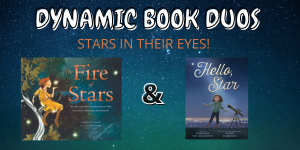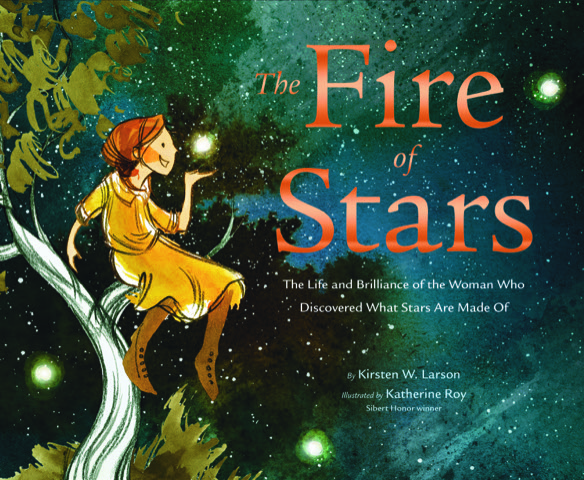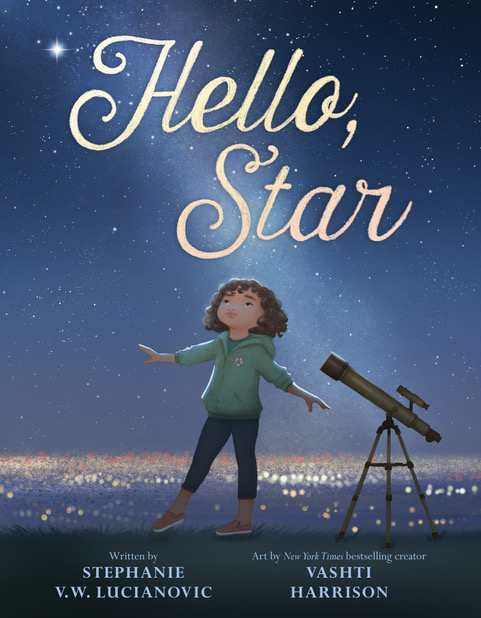
Please welcome authors Kirsten W. Larson and Stephanie V. W. Lucianovic to Dynamic Book Duos– a blog featuring two books that pair together in a meaningful way along with coordinating educational activities to strengthen reading skills. This week’s Dynamic Book Duos pairing focuses the stars in the eyes of the main characters.
PERFECT PAIR: Stars In Their Eyes!
The Fire of Stars: The Life and Brilliance of the Woman Who Discovered What Stars Are Made Of written by Kirsten W. Larson and illustrated by Katherine Roy and Hello, Star written by Stephanie V. W. Lucianovic and illustrated by Vashti Harrison are astronomy picture books that highlight a child’s curiosity, passion, and perseverance, while simultaneously teaching about star life cycles. In both stories, the main characters fall in love with science and nature as children and must overcome obstacles to achieve their dream of a life among the stars. While THE FIRE OF STARS shows students how stars are born, HELLO, STAR shows how they can die in brilliant supernovas.
Book 1: The Fire of Stars: The Life and Brilliance of the Woman Who Discovered What Stars Are Made Of

The true story, The Fire of Stars, is a dual read aloud about the formation of stars and the formation of astrophysicist Cecilia Payne as a star scientist. In her groundbreaking dissertation, Cecilia Payne discovered what stars are made of – hydrogen and helium – paving the way for more discoveries about the stars. The book ends with big questions that flowed from Cecilia’s research, including, “How do stars form?” “Where do they get their enormous energy?” and “Whose will the next discovery be?”
Book 2: Hello, Star

Hello, Star picks up on this theme as a small girl sees a bright star in the night sky and learns it’s a dying star. She sets out to learn all she can about the universe, while providing comfort to the star along the way. It’s a wonderful way to teach not just astronomy, but empathy as well.
EDUCATIONAL ACTIVITIES:
Activities for The Fire of Stars:
Activities for Hello, Star:
Activities for Both Books:
Writing Activity: Star Renga
Scientists’ work builds upon each other, discovery by discovery. At the same time, new stars are literally built from pieces of old stars. In this activity, students will write a collaborative poem, a Renga, about the stars. Renga mean “linked poem” in Japanese, and each stanza builds on the last.
Help your students learn about the Renga form. A Renga alternates haiku (3 lines of 5-7-5 syllables) by one author with a couplets (two lines of 7 syllables each) by the next. For younger children, you might disregard the requirements that they have a specific number of syllables in each line.
Share examples of Renga poems. See the book, BIRDS ON A WIRE by Patrick Lewis. Or find an example online at the Young Poets Network.
Challenge your students to write a collaborative Renga poem about stars, either on the whiteboard or through a shared document perhaps over the course of a week. Students should alternate haiku and couplets with each stanza building on the lost, like a train cars linked together.
Reading/Writing Activity: Words of Comfort
In both THE FIRE OF STARS (Cecilia) and HELLO, STAR (the star), characters struggle with being all alone and feeling lonely. Working as a class, in groups, or as individuals, look carefully at one of the two books. What evidence from the text and illustrations show how these characters feel? How could you encourage and comfort Cecilia or the star? You can write your response, draw a picture, or create a slideshow with your evidence and the way(s) you would comfort the lonely character.
Science Activity: The Life Cycles of Stars
Have students divide a sheet of paper into three columns. Label the first “Things we learned about stars.” Then, label the second “Questions we have about stars.” Lastly, label the third “Answers we found.”
While reading THE FIRE OF STARS and HELLO, STAR with the class (including the back matter), have students take notes about what they learned (facts) about star life cycles. One you are finished, have them jot down remaining questions in the second column. Discuss places they might look to find answers to fill in the third column.
(Note: Find online resources for investigating star life cycles here.)
Working together or individually, have students conduct their research.
Once students are finished, have them label the pictures on the Star Life Cycle Worksheet.
MEET THE AUTHORS:

